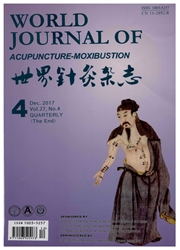

 中文摘要:
中文摘要:
目的:观察针药并用治疗脑梗死后轻度认知障碍的临床疗效及对患者日常生活能力的影响。方法:将72例患者采用随机数字表法分为治疗组(A组)和对照组(B组),每组各36例。治疗组采用主穴为百会、四神聪、四白、风池、完骨、天柱、神门、内关、水沟、三阴交、太冲、丰隆以“调神益智”,针刺结合尼莫地平片进行治疗,对照组单纯予尼莫地平片治疗。两组均连续治疗3个月后以MoCA量表来评价疗效。结果:治疗组显效率为69.4%,总有效率为91.7%,对照组显效率为55.6%,总有效率为80.6%,两组差异具有统计学意义(P〈0.05)。两组患者治疗后MoCA量表评分与同组治疗前相比,A组治疗前为20.23±4.67,治疗后为26.84±3.87;B组治疗前为19.82±3.56,治疗后为23.33±2.78,分数均较治疗前有所增长,且治疗组分数升高幅度(6.61±0.80)大于对照组(3.51±0.78),差异有统计学意义(P〈0.05)。结论:“调神益智”针法结合尼莫地平片是治疗脑梗死后轻度认知障碍的有效方法,针药并用的疗效优于单纯服用尼莫地平。
 英文摘要:
英文摘要:
Objective To observe the clinical effect of acupuncture in combination with medicine in the treatment of mild cognitive impairment after cerebral infarction as well as the impact on patients' daily living ability. Methods Seventy-two patients, in accordance with random number table, were divided into two groups, acupuncture combined with western medicine group (group A) and western medicine group (group B), each group with 36 patients. In combination with nimodipine tablets, acupuncture which can regulate the mind and reinforce the intelligence [making Baihui (百会 GV 20), Sishencong (四神聪EX-HN 1), Sibai (四白 ST 2), Fengchi (风池 GB 20), Wanggu (完骨 GB 12), Tianzhu (天柱 BL 10), Shenmen (神门 HT 7), Neiguan (内关 PC 6), Shuigou (水沟 GV 26), Sanyinjiao (三阴交 SP 6), Taichong (太冲 LR 3), Fenglong (丰隆 ST 40) as the main acupoints] was given in the treatment group (group A) while only nimodipine tablets were given in the control group (group B). The efficacy of these two groups was evaluated by Montreal Cognitive Assessment (MoCA) Scale after the continuous treatment for three months. Results The remarkably effective rate was 69.4%.and the total effective rate was 91.7% in the treatment group, while the remarkably effective rate was 55.6% and the total effective rate was 80.6% in the control group; the differences between the two groups were statistically significant (P〈0.05). When comparing the MoCA score before and after treatment, which was 20.23±4.67 before treatment and 26.84±3.87 after treatment in group A; 19.82±3.56 before treatment and 23.33±2.78 after treatment in group B, it was found that the score for both groups became higher after treatment than that before treatment. Furthermore, the increase of the score was higher in the treatment group (6.61±0.80) than that in the control group (3.51±0.78) and the differences were statistically significant (P〈0.05). Conclusion Acupunctu
 同期刊论文项目
同期刊论文项目
 同项目期刊论文
同项目期刊论文
 期刊信息
期刊信息
